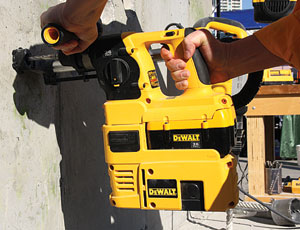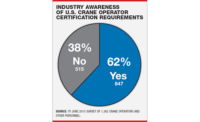The sinister effects of inhaling crystalline silica—which, like asbestos, slowly leads to lung disease and cancer—have been known for years. Only recently have tools that trap the deadly dust become widely available.
“There’s been a drumbeat,” says Matt Gillen, senior scientist at the Washington, D.C.-based National Institute for Occupational Safety and Health. Over the last decade, more suppliers have brought out controls designed to capture dust at the source: the business end of the drill, chop saw, hammer or grinder. Forget about dust masks—they are the last line of defense, scientists say.
“There are two basic approaches, local exhaust ventilation and wet methods,” says Gillen. “You are seeing both.” At the federal level, the U.S. Occupational Safety and Health Administration has plans to update its out-of-date dust standard this July. At the local level, large cities are now enforcing rules that ban dust that affects the public. Some two million workers are exposed to silica dust, and as many as 7,000 new cases of silicosis arise each year in the U.S., OSHA says.
Concrete and masonry workers are at high risk. At this year’s World of Concrete, held Feb. 2-5 in Las Vegas, it was difficult to survey new tools without noticing the array of dust options available. Once a retrofit, dust extractors now are sold new with many tools. And they are more portable. DeWalt showed a cordless unit on its 28- and 36-volt rotary hammers. Due out this summer and adding $250, doubling the cost of the tool, it eliminates the need to hook up to a vacuum and accepts a HEPA filter.
“No cord, no dust, this is going to be a home run,” says Mike McDowell, a product manager for Towson, Md.-based DeWalt. The device continues to suck two seconds after the drill shuts down so that extra dust at the end of the bit doesn’t disperse into the air when the tool pulls away. Like other manufacturers, DeWalt also offers a cheaper, $100 telescopic extractor that plugs into a vacuum.
Dustless Technologies, Price, Utah, sells HEPA vacuums and shrouds as well as private labels for tool manufacturers. Dustless spokesman David Thompson says the U.S. Environmental Protection Agency in April will require remodelers to trap dust to prevent the spread of lead paint. “Even though the construction industry is somewhat contracting because of the economy, dust control is a field that’s enjoying some growth,” he says.
Vacuums, however, have a standardization problem: A regular shop vac may use a HEPA filter, but it may not be fit for heavy-dust duty or have a bag to trap silica. Another issue is electrical: In a stroke of innovation, Bosch, Mt. Prospect, Ill., has introduced vacs costing up to $399 that include a step-down switch—called the Power Broker—to reduce the vac’s amperage. Now, the load of the power tool, which plugs into the vac for convenience, won’t blow a fuse. But with fewer amps comes a tradeoff in suction power.
Hilti Inc., Tulsa, offers dust removers and vacs, wet and dry, for more than two dozen of its tools. Typically, the shrouds add about $200 but can double the cost of smaller tools, such as grinders. Although Hilti is trying to convince clients that dust control pays off in cleanup costs—not just health—the devices still command a tiny piece of the market. “About 8% of the tools that could have dust collectors are sold with dust collectors,” says David Schimmel, a Hilti marketing director.
Next month, Minneapolis-based Mortenson Construction plans to test various dust-collection tools as part of an ongoing program to reduce the risk of silicosis on its jobsites. “All we’re trying to do is gather some data,” says Paul Penzkover, safety director at the contractor’s Chicago office. “And we are trying to educate our workforce on the hazard.”





Post a comment to this article
Report Abusive Comment